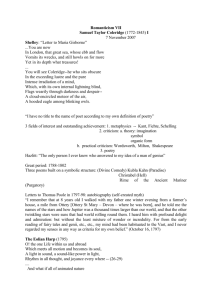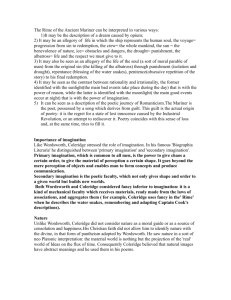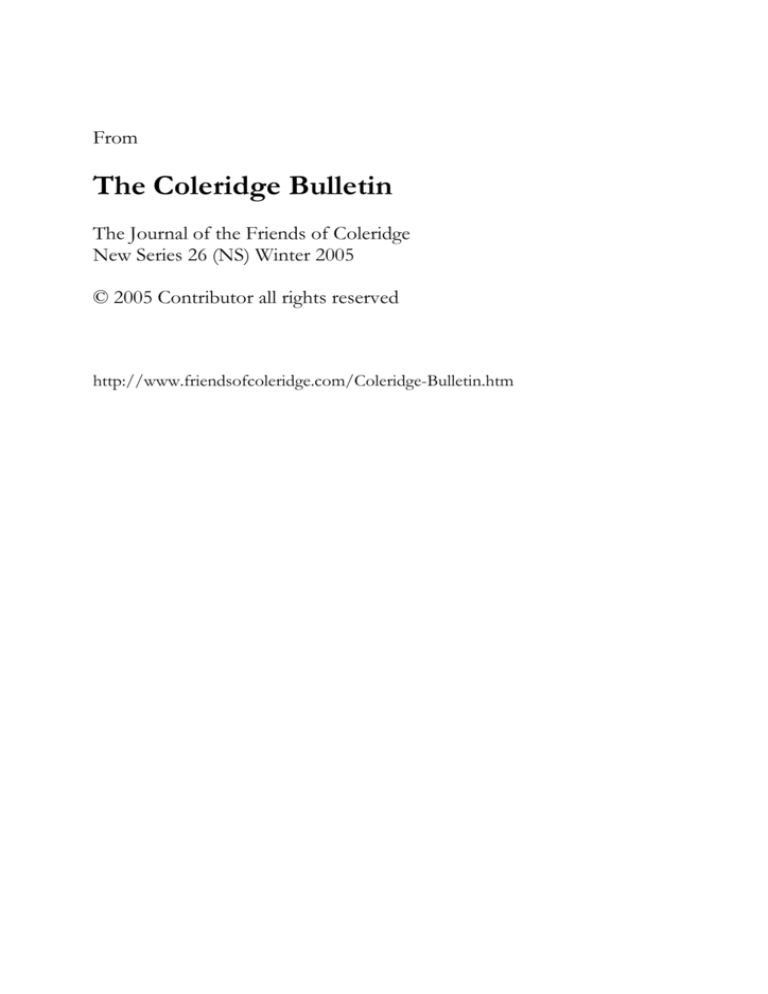
From
The Coleridge Bulletin
The Journal of the Friends of Coleridge
New Series 26 (NS) Winter 2005
© 2005 Contributor all rights reserved
http://www.friendsofcoleridge.com/Coleridge-Bulletin.htm
‘Frost at Midnight’—Some Coleridgean Intertwinings
Peter Larkin
____________________________________________________________________________________________
L
ET ME BEGIN with a quotation from Hölderlin to honour Coleridge’s
love of things German:
…conversation
Is good, and to say
What the heart means… 1
This fragment of Hölderlin comes from the poem ‘Andenken’ featured in an
article resonantly called ‘On the Misery of Theory without Poetry’. 2 What
drew me to this essay wasn’t the theme of conversation but the more unusual,
though not unrelated, topic of greeting: how do we as readers greet a poem?
Most conversations start with a greeting, so is there a literary equivalent? The
essay argues that if we are astounded by the sheer beauty of a poem, we will
have missed our encounter with it if we simply dissolve into awe. 3 Instead, we
need to move on with the poem, so that rather than overwhelming it with our
learning we allow the poem to induce in us an inward pause, which brings us to
a threshold of expectancy or a ‘neighbourhood of the questionable’. 4 The
poem gives in order to be able to ask, and its question is: Where are my
friends? This, explains the article, is not a pleading for a short-cut to
friendship but a poet’s petition, one which asks for ‘a kind of destinal
granting’. 5 Ronell concludes that greeting must be a trope for the poetic word,
a word which as such remains precarious and questioning. 6 And we might add,
that, where a greeting leads to a conversation we readers don’t leave things
where they were: we invite the poem to share its question with us, so that
questioning is not so much the ultimate word but a shared word; as such the
poem can move on with us.
Geoffrey Hartman once suggested that the only adequate response to a
work of art is what he calls ‘a work of reading’: this is not to surround a poem
with commentary so much as to offer the energy of the poem a collaborative
future by inviting a whole cross-section of preoccupations to participate in our
response. 7 The conversation broadens but remains within the original horizon
of greeting. What I shall attempt in this essay is to greet the Coleridge of
‘Frost at Midnight’ by staying with the poem as it travels on to encounter a
later, more philosophical Coleridge, and even further toward some modern
____________________________________________________________________________________________
1
Friedrich Hőlderlin and Eduard Mőrike: Selected Poems, trans. Christopher Middleton (Chicago: University of Chicago
Press, 1972), 91.
2
See Avital Ronell, ‘On the Misery of Theory without Poetry: Heidegger’s Reading of Holderlin’s “Andenken”’,
PMLA, 120, 1 (2005), 16-32.
3
Ronell, 19.
4
Ronell, 26.
5
Ronell, 30.
6
Ronell, 31.
7
Unpublished comment at the conference Culture and Critical Form: Reading after Geoffrey Hartman, University of
Warwick, May, 1993.
23
‘Frost at Midnight’—Some Coleridgean Intertwinings
____________________________________________________________________________________________
Coleridgean ‘second selves’ in the unlikely form of 20th century French
phenomenologists. We all know what Coleridge felt about the French, wanting
to stand four-square against ‘French philosophy and modern Materialism’ (CL
V 8) but figures like Maurice Merleau-Ponty or Jean Louis Chretien are not
chips off the same block as a Voltaire or Condillac. These more recent
philosophical writers are as much soaked in the German transcendental
tradition as Coleridge himself, and STC did say, wryly enough, in a notebook
entry, that French is ‘the very own language of conversation’ (CN II 2431). So
this essay will be offered in the spirit of the critical study by David Haney in
which he undertakes a ‘meta-conversation’ between Coleridge and a number of
contemporary thinkers. The aim, Haney says, is not to catalogue the weak or
strong points on either side of the conversation, but ‘rather to have the
conversation and reflect on it’. 8 Where Coleridge challenges us, in Haney’s
view, is where he prompts us to attend to both his world and ours with care, so
that his texts ‘speak’ to us in ways that can produce shared and living insights.9
The theologian John Milbank has written of Coleridge that his significance is
not that he anticipated many of our contemporary concerns, but rather that ‘he
stands alongside us on the margins of still unresolved problems.’ 10
II
The opening line of ‘Frost at Midnight’ is muted but not tentative: the frost
‘performs’, the word itself tempting us to imagine a rogue etymology whereby
the ministry is carried out by working its way through the forms around it.
There is also a sense that this windless night is somehow primordial, prereflective, or perhaps proto-spiritual. The owlet’s cry indirectly introduces the
speaker’s own waking solitude which rouses nobody else in the cottage; the cry
helps pierce an internal solitude that seems already reaching out for a means of
communicating with the surrounding silence. Perhaps the sharp cry is just how
the frost itself would sound if its silence could be transposed. It arouses
attention but is far from conversational. Are the poet’s musings the more
abstruse because of the hour, or because they reach past themselves, ‘abstruser’
than any known object might require? ‘Abstruser’ might also figure a mind
half-awake but there is real sleeping going on beside the poet, a child which
mitigates the absolute solitude, an unconscious presence but one no less fully
present for all that. The cradled figure seems to have found its place much as
the frost also dwells obliquely and mysteriously, but the poet’s voice is neither
wholly inside, sharing the family space, nor outside (the frost is in part secret
because the poet is sheltered from it). The calm itself is provocative of that
____________________________________________________________________________________________
8
The Challenge of Coleridge: Ethics and Interpretation in Romanticism and Modern Philosophy (University Park, Pa:
Pennsylvania State University Press, 2001), 416.
9
Haney, op. cit., 8.
10
‘Divine Logos and Human Communication: a Recuperation of Coleridge’, Neue Zeitschrift fur Systematische Theologie
und Religionsphilosophie, 29 (1987), 73.
‘Frost at Midnight’—Some Coleridgean Intertwinings
24
____________________________________________________________________________________________
uneasiness (and as such pro-vokes the owlet’s cry), being the product of an
‘extreme silentness’, so monolithic as to verge on separating the poet from any
sense of relation or stable object of meditation. Is it the silentness of very little
or of a whole world? It seems a silence wrapping in itself a multifarious
landscape whose complexity is uneasily reduced to this minimalism in which its
life has become ‘inaudible as dreams’. What should be there no longer behaves
as if it were there; which is disturbing because in the poem this exactly
rendered world seems to be actively mimicking its own intangibility, realising
an unreality paradoxically one step ahead of those abstruser schematicisms of a
poet who might be tempted to reduce it to an unreality of his own devising. As
the phrase ‘sea, hill and wood’ repeats itself like the owl-cry it is as though a
silent village is peopled only by these non-human features, and the daytime
distinction between human and non-human is both intensified and reduced in
such a marginal scene. Wordsworth, in his notebook, could liken the ripplings
and murmurs of landscape to a ‘peopled solitude’ (WP V 341), but here the
frost has translated a populous scene to another medium which the poet can’t
bring to focus, despite the implied precision of the frostiness. Kelvin Everest
compares this to the effect of a ‘silent film’, 11 but it is one almost immediately
modified by a fluttering film in the grate which returns the poet to an audible
space. While the frost is both present and secret, the sooty film is distractingly
visible but not entirely real, an unquiet thing less than a meaningful object, but
for that reason a ‘companiable thing’, a perception offering itself to phantasy
rather than observation, to a weird internal topology rather than the
topographic layers of cottage, village and hill. An insufficiently centred self
converses with a derived or partial object. In a future Notebook entry,
Coleridge will remark on how a coal-fire induces in him the conscious fantasy
of shrinking to a Lilliputian so that the embers become like mountains in
contrast (CN II 2402). In ‘Frost at Midnight’ the speaker is already
substantially diminished by the inaudibility of the outer world, not to speak of
his abstruser musings equally inaudible to his own inner self, but at the same
time his thoughts are diverted by a riddlingly active ‘companionable form’
which is not a spectre nor a self-conscious illusion.
The middle section of the poem, which pursues the image of the
‘stranger’, contrasts loneliness amid a crowd of school-fellows with a solitude
from within a family circle. The word ‘stranger’ itself could denote an
expected child in seventeenth century English and we know that Coleridge was
expecting his second child in a matter of weeks. 12 The ‘gentle breathings’ of
the babe recall the poet to his present situation, a calm which is able to hear
and inhabit ‘the interspersed vacancies/ And momentary pauses of the
thought’; the extreme outer silentness has been mediated by the freaks of a
film of soot which, though uneasily marginal in itself, is effective at distracting
____________________________________________________________________________________________
11
Coleridge’s Secret Ministry: the Conversation Poems, 1795-98 (Hassocks: Harvester Press, 1979), 260.
12
See Matthew Vanwinkle, ‘Fluttering on the Grate: Revision in “Frost at Midnight”’, Studies in Romanticism, 43 (2004),
588.
25
‘Frost at Midnight’—Some Coleridgean Intertwinings
____________________________________________________________________________________________
the mind from a quasi-paralysis. Coleridge writes himself into greeting the
scene around him, which enables him, in turn, to greet the babe as a true object
of attention:
My babe so beautiful! it thrills my heart
With tender gladness, thus to look at thee. (ll. 48-9)
Although the speaker recurs to musing on the comparative deprivation of
schooldays where memories of ‘cloisters dim’ do not figure among dim
underlying sympathies, the imagery of ‘sky and stars’ removes us to a larger,
shared world. The ‘sky and stars’ is exactly where the ‘Great Universal
Teacher’ can be presumed to be most at home, together with that spirit-life
moulding the mind of the child amid scenes of nature by stimulating it to ask
for the being it already has. The deprivation of such scenery shows up in the
father’s uneasy habits of musing and questioning, though he is less concerned
to subvert or de-create than to track a way back to asking (while you might
question from where you are not, you ask from where you are). To ask is to sue
for relation with what has already been given. The gift remains a silent one,
perhaps so secret the poet doubts whether he has received it at all: by
acknowledging such a starting-point, however, Coleridge implicates a desire to
bring it more fully into figurative life and relationship.
The concluding, superbly pared-down verse paragraph completes the
‘rondo’ which for Coleridge enacted best the conversational pattern which had
not quite been caught, to his mind, in earlier, longer versions of the text. Some
critics take the repeated use of ‘Whether’ (in ‘Whether the summer… whether
the eve-drops… (ll. 66-70)) as an index of uncertainty. I read the word as
hinging on a more confident celebration of the cycle of season giving way to
season, a set of open possibilities held in a stable equilibrium. We are given a
marvellous set of correspondences which reinforce the interlinking of the
seasons in very compressed form: summer green is rhymed in winter (despite
bare branches) by a mossy apple-tree; the singing redbreast suggests springtime
while his hue transfers by implication to the apples on the tree to figure the
ripeness of autumn. The smoke of a winter fire turns out to be the gentle
steam of a thaw, and the droplets under the eaves, now arrested by frost, call
up the globe of the moon in an embracing rather than alien silence. It is only
in the ‘trances of the blast’ we actually hear the droplets fall, a telling phrase
which seems to hark back to the witching time of ‘extreme silentness’. ‘Pauses’
of the blast might have allowed the sun-thaw droplets to be gentle audible, but
the stronger figure of ‘trance’ directly summons the sense of a ‘secret ministry
of frost’ which, by solidifying the droplets in what John Beer calls ‘a principle
of concretion’, 13 conjoins the quietly shining icicles to the ‘quiet Moon’.
The imagery of ‘Frost at Midnight’―its catalogue of smoke, cloud,
droplets, moon, sooty film, icicle―are all intermediate appearances arising from
____________________________________________________________________________________________
13
Coleridge’s Poetic Intelligence (London: Macmillan, 1977), 139.
‘Frost at Midnight’—Some Coleridgean Intertwinings
26
____________________________________________________________________________________________
some more primitive state which suggests both insufficiency and inter-relation.
They possess, if you will, an intermediate way of being: all immensely particular
objects of perception but all transitional states of or moments in their world.
They are secondary entities: the moon reflects the sun, smoke derives from fire
and icicle from water and so on. They enter the poem from within a sense of
marginality but are woven together by its dialogical process to invoke a
continuous community of active relations, as the cycle of transformation and
season that moves through them has no single point of privilege. Such
intermediate forms of themselves ‘quieten’ the stark difference between subject
and object which was to haunt Coleridge throughout his life. They speak
quietly of difference from within an im-mediacy already in relation to what
withdraws as they approach. Or their own presence is a sort of withdrawal, a
secret ministry of its own. The icicles ‘quietly shining to the quiet Moon’
provoke us to imagine this quietness as something secondary and local, less
than elemental. The icicles are quiet because their frozen state removes from
them the restlessness of living water; Lou Thompson has suggested that ‘quiet’
often bears a connotation of stillness; 14 the lack of noise may figure other sorts
of positive lack. The moon is a larger droplet englobed in the heavens and not
the origin of its own light but casting a light mild enough to be in relation to
what shines toward it. The icicle’s shining is even more derivative than the
moonlight but the ‘shining to’ is a moment of freedom and space. The
quietness still belongs to the prevailing silence but is able to modify it by
suggesting something more palpable, still dedicated to silence perhaps but no
longer as figuring isolation. On the contrary, the whole scene bespeaks
participation. A primordial sun might dazzle any such relation out of existence
and remains at a distance, though always implied as the opposite pole of
midnight. The ontological conversation between all these images appears
provisional. To what extent are these entities intended to be exemplary, or is
their own mode of relations itself open to other horizons than the prevailing
ethos of the immanent and the supplementary?
III
One horizon with which ‘Frost at Midnight’ is much involved is that of its
own philosophical preoccupations, much evident in a poem which one critic
has labelled ‘a sort of philosophical lullaby’. 15 Earlier versions of the text were
even more explicit about what might flow from a ‘self-watching subtilizing
mind’. The fact that by 1817 and after Coleridge had simplified these lines to
refer more succinctly to ‘a toy of Thought’ indicates not just his concern to
produce a smoother aesthetic effect, but that he was still trying to realise more
of the suspensive or ‘hanging’ quality of the poem’s internal conversation with
____________________________________________________________________________________________
14
‘What is the Sound of One Icicle Shining? Silence and the Koan of “Frost at Midnight”’, unpublished paper given
at the Coleridge Summer Conference, Cannington , July 2004.
15
See Robert Crawford, ‘”My Babe So Beautiful!”’, Times Literary Supplement, 26 November, 2004.
27
‘Frost at Midnight’—Some Coleridgean Intertwinings
____________________________________________________________________________________________
itself. The conversation is now overheard by a philosopher, a philosopher who
interrupts at times, but as the poem goes on rewriting itself he is also someone
who gradually learns to substitute a phenomenological patience in the face of
experience, rather than agonize over epistemological quandaries.
I have introduced the term ‘phenomenological’ which I want to draw into
the very conversation’ ‘Frost at Midnight’ draws us readers into. What I hope
this will illustrate is less Coleridge’s own intellectual background as he wrote
the poem while mulling over themes in Hartley and Berkeley, 16 than how the
poem establishes a more intimate tension between the imaginative and the
schematic, anticipating resources not yet available to its author, and also raising
questions of aesthetic experience as wholly internal to thought. Part of the
conversational idiom of the poem lies not just in how imagination reconciles
discordant elements, but in how that very conversational texture exposes itself
to an imagination which can be burdened, hindered and interrupted.
Imagination presents itself here as an emergent power called on to fill a breach:
Hume’s dismantling of knowledge had led to a ‘withering of the philosophical
appetite’ in England, so that it fell more to poets like Wordsworth and
Coleridge to struggle with a more self-consciously philosophical poetry as a
matter not just of experimental form but also of content. 17 In 1796 Coleridge
had remarked to Southey how he ‘cannot write without a body of thought―hence
my Poetry is crowded and sweats beneath a heavy burthen of Ideas and Imagery
(CL 1 74). In ‘ Frost at Midnight’ these sweats of ideas and imagery are held at
bay by the icicles, as suspended but concrete particles of the world; when they
revert to droplets in the thaw a living situation has mingled itself with the
burden of thought. In the famous letter to Thelwall of 1796 (where Coleridge
highlighted what he called the ‘divine Chit-chat of Cowper’) he also claimed
that his ‘philosophical opinions are blended with, or deduced from, my
feelings: & this, I think, peculiarizes my style of writing’ (CL 1 279). One critic
has gone further and insisted that for this poet it is the feeling which sets
intellect in motion. 18 For David Miall, this intimacy of style as thought and
thought as style has an anticipatory quality, which for me implies a prescience for
ideas yet to articulate themselves on the one hand, and a patience with
experience too complex for summary analysis on the other. 19 Coleridge was
always delighted by instances of anticipation and noted with relish how the
Italian Giordano Bruno somehow ‘knew’ about the circulation of the blood
thirty years before Harvey (CN 1 928). This was just how he liked to think of
himself in relation to Kant and much of contemporary German
Naturphilosophie. By feeling Coleridge included a ‘feeling for’, an intuitive sense
concrete and intimate enough to be equally overflowing with speculative
____________________________________________________________________________________________
16
See James D. Boulger, ‘Imagination and Speculation in Coleridge’s Conversation Poems’, Journal of English and
Germanic Philology, 65 (1965), 702.
17
See Tim Milnes, ‘Through the Looking-Glass: Coleridge and Post-Kantian Philosophy’, Comparative Literature, 51, 4
(1999), 310.
18
See Richard H. Fogle, The Idea of Coleridge’s Criticism (Berkeley, LA: University of California Press, 1962), 28.
19
‘The Displacement of Emotions: the Case of “Frost at Midnight”’ (The Wordsworth Circle, 20, 2 (1989), 99.
‘Frost at Midnight’—Some Coleridgean Intertwinings
28
____________________________________________________________________________________________
energy. As the theologian Donald MacKinnon acknowledged, it was as a poet
that Coleridge came to Kant, with problems and queries first raised by his own
poetic practice. 20
The matters which the Conversation Poems touch on are not limited to
drawing-room exchange, however nuanced this might be in Cowper. It has
been pointed out how these poems give us instances of the imaginative process
unifying experience, but they also open us to the unbridled power of
speculative reason which as often serves as an obstruction to the tentative
intertwinings of imaginative threads. This can be traced to the persistent
contradictions in Coleridge’s life and world. 21 The conversational style was
equally capable of steering Coleridge into tight corners but with this style he
wasn’t simply courting danger but also eliciting new resources. Above all, the
Conversation Poems were readable. When he introduces the occasional
quotation from them in his later writings, they remain close to Coleridge’s vital
intellectual concerns which they had gone on underlying and fleshing out.
Similarly, these poems draw us readers on with our own thoughts and
associations, many of which Coleridge could not have foreseen; for us too the
poetry makes itself felt in new contexts, summoning off fresh fields resonances
we had not realised we were going to find already embedded there.
Let me attempt to illustrate this by looking at some themes in 20th century
phenomenology in the company of Coleridge, until we are drawn back to
‘Frost at Midnight’ itself. Phenomenology would have been known to
Coleridge as a German term in his lifetime. The word first appears in the
writings of J H Lambert in his Neues Organon of 1764, where it is used to
indicate a study of the forms both appearances and illusions take. The idea
itself probably goes right back to Aristotle who famously sought to ‘save the
appearances’, by which he meant any good explanation should start from how
we experience things and how they naturally appear to us: he put us on our
guard against the counter-intuitive. Kant took over the word phenomenology
from Lambert, using it to show how the principles of sensibility and
understanding only apply to a world of appearances and not to things as they
might be in themselves. We know Coleridge felt ambivalent about this,
yearning for a form of perception that was vital and truly ontological, but at
the same time respecting Kant’s insistence that being always holds back
something in reserve as unknowable, which Coleridge welcomed as a buttress
against pantheism. But Coleridge was disappointed Kant didn’t believe it was
possible to demonstrate the nature of ultimate reality, though Kant held that
everything implied the existence of an absolute reason; Coleridge consoled
himself, however, with the thought that such an affirmation was already
implicit nearer to home in the writings of Bacon, Baxter and Leighton. 22
It is Edmund Husserl (1859-1938) whom we acknowledge as the founder
____________________________________________________________________________________________
20
‘Coleridge and Kant’ in Coleridge’s Variety: Bicentenary Studies, ed. John Beer (London: Macmillan, 1974), 192-3.
21
Boulger, op. cit., 692.
22
See John Beer, ‘Editor’s Introduction’, AR, cxix.
29
‘Frost at Midnight’—Some Coleridgean Intertwinings
____________________________________________________________________________________________
of phenomenology as a modern movement, and who, like Coleridge, spent
time at the University of Gottingen. He defined phenomenology as an attempt
to uncover the nature of meaning through examining human consciousness, a
mind which always acts to place its meaning in a world. 23 Husserl wanted to
account for how the miracle of objectivity within subjectivity is brought about.
As one commentator puts it: ‘we live naively in this world, swimming with the
flow of its givens’ and Husserl becomes aware of the phenomena of the
connectedness of all experience, or what we recognise as ‘a world’. 24
Swimming with the flow of givens is certainly one obvious starting-point for a
Coleridge Conversation Poem.
One can argue for a temperamental affinity between Coleridge’s thought
and modern phenomenology, despite differences of language and emphasis.
There is a resemblance in the style of thinking: for Coleridgeans this dictum by
Maurice Merleau-Ponty, a disciple of Husserl, has a familiar ring: ‘the
unfinished nature of phenomenology and the inchoate atmosphere which has
surrounded it are not to be taken as a sign of failure―they were inevitable
because phenomenology’s task was to reveal the mystery of the world and of
reason. 25 Husserl, like Coleridge, left unpublished work and masses of
notebooks at his death, and Merleau-Ponty himself never finished his most
significant later work, The Visible and the Invisible. The text as we have it tails off
into working notes after its last completed chapter called ‘The Intertwining’.
Coleridge might well have wryly felt at home with these people, one feels.
IV
How do some of Coleridge’s philosophical dilemmas intertwine with MerleauPonty’s own attempts to hold together inner and outer worlds in the midtwentieth century intellectual landscape, many of whose distinctive features
were being laid down in the period Coleridge lived through? Coleridge might
well have warmed to a man who could write: ‘Every incarnate subject is like an
open notebook in which we do not yet know what will be written’. 26 For
Merleau-Ponty, the act of perception itself seemed the key to overcoming
subject-object dualism and to being drawn into the world. As Merleau-Ponty
wrote: ‘I grasp myself, not as a constituting subject which is transparent to
itself… but as a particular thought, as a thought engaged with certain objects as
a thought in act; and it is in this sense that I am certain of myself’. 27 Coleridge
____________________________________________________________________________________________
23
See Jeff Malpas, ‘From the Transcendental to the “Topological”: Heidegger on Ground, Unity and Limit’, in From
Kant to Davidson: Philosophy and the Idea of the Transcendental, ed. Jeff Malpas (London: Routledge, 2003), 87.
24
See Dermot Moran, ‘Making Sense: Husserl’s Phenomenology as Transcendental Idealism,’ in From Kant to Davidson:
Philosophy and the Idea of the Transcendental, ed. Jeff Malpas (London: Routledge, 2003), 63.
25
See James B. Steeves, ‘The Virtual Body: Merleau-Ponty’s Early Philosophy of Imagination,’ Philosophy Today, 45, 4
(2001), 373.
26
Maurice Merleau-Ponty: Basic Writings, ed. Thomas Baldwin (London: Routledge, 2004), 37. Cited hereafter as Basic
Writings.
27
The Primacy of Perception and Other Essays on Phenomenological Psychology, the Philosophy of Art, History and Politics, trans.
James M. Edie (Evanson, IL: Northwestern University Press, 1964), 22.
‘Frost at Midnight’—Some Coleridgean Intertwinings
30
____________________________________________________________________________________________
possessed a strong sense of ‘outness’ (Berkeley), a sense of something uniquely
given to common sense or ‘simple realism’ (Reid) which refuses to derive
knowledge from a calculus of our representations. As John Milbank observes,
the human mind doesn’t copy from nature, its apprehension is ‘inscrutable and
direct’. 28 Merleau would have agreed with Coleridge that a poet’s heart and
intellect should be ‘intimately combined and unified, with the great
appearances in Nature’ (CL II 864) and we know that Coleridge’s later
theosophy was concerned above all with the nature of action: that any possible
synthesis not a mere static formula but must be the fruit of a progressive act.
Where Coleridge describes how by deep feeling we make our ideas dim in what
is a deep and steady feeling which identifies the ‘Percipient & the Perceived’,
he is already doing a species of phenomenology (CN I 921). It is true later
Coleridge generally sees objects in need of being redeemed from their chaos by
consciousness while Merleau-Ponty stakes his thought on a principle of
inherent organisation essentially shared between mind and world. Coleridge
seems to concede this when he refers to ‘actual impressions’ possessing a
‘uniform significancy’ or ‘that apparent contingency and promiscuous position
of Objects by which Nature or the World of the bodily sense is discriminated’
(CN III 3474). As a poet Coleridge is always sensitive to the complex selforganising life of things in the world. He was to come to understand that
where the Primary Imagination does its work, it essentially reaches outwards in
sympathy with the plastic powers in nature. 29 And we should remember that in
his famous definition of the Secondary Imagination as ‘essentially vital even as
all objects… are essentially fixed and dead (BL I 304), he was careful to qualify
the term ‘objects’ within the parenthesis ‘as objects’; in other words, objects are
fixed and dead when they are less than living phenomena, a failure not present
in his poetry unless afflicted by dejection. For Merleau-Ponty, the body itself is
ontological because it actively places itself in the world, it is not the inert
platform for a living spirit. The same must be true of any Coleridgean body
which imagines. Early Coleridge stressed the corporeality of thought (CL I
137) and his increasing interest in a power he had yet to name as imagination
was a path from the concrete mechanisms of a Hartley towards a spiritual
horizon not reducible to the dogmatic idealism of a Berkeley. Coleridge’s own
sense of self was challengingly pieced by an actual world, and he knew well that
his own ‘slender Thread’ of Fancy always fastened itself to ‘something below
(CN II 2166). The phenomenological body is not in space like things,
Merleau-Ponty would want to say, ‘it inhabits or haunts space’ which is what
Coleridge’s secondary imagination also does, and we have only to bring to
mind the Ancient Mariner or Christabel to think of haunting and haunted
bodies. 30
In his later and unfinished work, Merleau-Ponty moves from emphasis on
____________________________________________________________________________________________
28
Milbank, op.cit.,63.
29
Milbank, op. cit.,64-5.
30
Basic Writings, 36.
31
‘Frost at Midnight’—Some Coleridgean Intertwinings
____________________________________________________________________________________________
bodily perception to a more mysteriously speculative element which he simply
names ‘flesh’. By this he doesn’t intend a materialist triumph because it is
precisely flesh which reveals the invisible within the visible aspect of things; it
is not just the human body which partakes of ‘flesh’―rather it is a property
common to all the vital layers of the world which see and touch one another.
For the Coleridge of The Friend, religion defines itself as ‘the act and habit of
reverencing THE INVISIBLE, as the highest both in ourselves and in nature’ (F I
440). Merleau-Ponty connects visible and invisible things to the idea of an
‘intertwining’, by which he means we only really see our world because we are
ourselves visible objects within it―we touch it because we are touched by it.
These are ontological rather than contingent properties, all based on
interaction, key elements in a world of participation. This avoids being another
supreme synthesis which would risk falling back onto the sort of formulaic
absolute Coleridge so much dreaded. Rather, it offers a world of exchange and
reversibility which represents for Merleau-Ponty something more truth-like
than any supreme synthesizing of these inter-relations. To express this,
Merleau-Ponty borrowed the figure of chiasmus, symbolized by the Greek chi
which looks like an X and which stands for a general exchange of qualities; the
process is never completed, however, but folds and turns within itself, a
process the French philosopher compares to the flesh possessing a flap or leaf,
different moments of which are in play without rigidifying into subject or
object. Coleridge, in a Keswick letter , could liken his own spirit to a leaf
eddying in autumn and relate that to the intense feeling for the universal spirit
arising within himself (CL II 916). The figure of chiasmus in itself can denote
divine harmony for Coleridge, as one critic, writing about ‘Frost at Midnight’
has suggested. 31 Coleridge’s underlying sense of form demands that if plurality
always presupposes unity, that many must be one, the reverse is also equally
true, that the one must be many. 32 For both philosophers this is more than a
dialectic because chiasmus symbolises a primordial current of sharing out and
actualisation. For Merleau-Ponty philosophy discovers itself to be already
placed in an ongoing world, a world which elicits this insight but beyond that
requires no formal or narrowly intellectual solution; such an act of perception,
however, draws upon a mysterious reservoir of primordial faith. 33 Coleridge’s
own ‘primal act of faith’ is enunciated in the word God, a ‘faith not derived
from experience but its ground and source’ (LS 18). Merleau-Ponty equally
goes beyond external experience but he believes the ground for doing so is
given by the world itself. Transcendence, for Merleau-Ponty, is this very world
which eludes our grasp, so much so that any absolute self would be so closed
in on itself it would be unable (ironically enough) to turn toward a divine
____________________________________________________________________________________________
31
See Jan Plug, ‘The Rhetoric of Secrecy: Figures of the Self in “Frost at Midnight,”’ in Coleridge’s Visionary Languages:
Essays in Honour of J.B. Beer, ed. Tim Fulford and Morton D. Paley (Woodbridge: Brewer, 1993), 36.
32
See Nick Reid, ‘Coleridge and Schelling: the Missing Transcendental Reduction,’ Studies in Romanticism, 33,3 (1994),
469.
33
See Steeves, op. cit., 374.
‘Frost at Midnight’—Some Coleridgean Intertwinings
32
____________________________________________________________________________________________
absolute. 34 Such was Coleridge’s fear also, faced with the high dialectical
ambitions of post-Kantian philosophy. Though he craved for method and
synthesis, he also insisted on a living Other which the human will desires to
relate to personally and progressively. Will is central too for Merleau-Ponty, as
experiences like love or hate can’t be proved philosophically but are only made
actual by an existential decision to love or to hate. When I will to love I
already find myself loving, and this is related to a primordial faith in
perception, so that where I enter into relation with the outside world I already
begin to understand it.
V
So with heads swimmingly conversant with possible points of contact between
Merleau-Ponty and Coleridge, let us retrieve ‘Frost at Midnight’. The key
image near the poem’s opening is the sooty film on the grate, that unquiet
presence which evokes in the poem a fear of the ‘phantasmal chaos of
association’ or the ‘fleeting chaos of facts’ as Coleridge was later to classify
similar experiences (BL I 116; LS 18). The ‘idling Spirit’ which toys with
thought, seeking ‘a mirror of itself’ seems to mock that transcendental spirit
which endeavours ‘to unite the insulated fragments of truth and frame a
perfect mirror’ as Coleridge eventually declared in his Table Talk. (TT I 248).
But perhaps the fragments of perception in the poem are not quite so
‘insulated’ as the poet imagines he fears. Rather than oscillating insecurely
between subject and object, a dead nature and a living vision, the film of soot
might itself be something like the flap or sheet which Merleau-Ponty sees as a
reversible leaf of inter-relation, a fold in the flesh of body and world which
promotes their intertwining. For Coleridge, the chaos of association needs to
be modified by the will, and by the will we can understand something nearer to
an active participatory consciousness which intends a living world for its object
(one hinted at in the idea of Primary Imagination) Coleridge’s own secondary
imagination with its stress on dissolving, diffusing and dissipating in order to
recreate might in practice take its origin from such an idling spirit, which as we
see in ‘Frost at Midnight’ can also be a way of letting be, of waiting on silence
and solitude, essentially modest but not meaningless ways of being in the
world. To dissipate can allow a letting-go which accompanies a coming-intoplace, being somewhere by interpenetrating its nondescript moments and
moods. Such flecks and marks, Merleau-Ponty would have us believe, are
parts of a particular world of playing and praying more primordial than any
purely conceptual space. 35 A conflicting but cohering locus emerges from this
concrete entwining of oneself and the world, which is to say: a conversation
about being is joined. Coleridge’s telling phrase ‘a companionable form’
____________________________________________________________________________________________
34
Basic Writings, 172.
35
See Glenn A. Mazis, ‘Merleau-Ponty, Inhabitation, and the Emotions’ in Merleau-Ponty: Critical Essays, ed. Henry
Pietersma (Lanham, MD: University Press of America, 1989), 264.
33
‘Frost at Midnight’—Some Coleridgean Intertwinings
____________________________________________________________________________________________
suggests an entity which promotes this intertwining process, an image which
sparks off a series of memories and anticipations, fears, hopes and implicit
promises between himself and the breathing presence of Hartley. The babe’s
potential one day to ‘wonder like a breeze’ itself derives from the more
immediate ‘gentle breathings, heard in this deep calm’ (l.45). As Jan Plug
notes, ‘As “companionable form” the film has already begun to be personified;
but as “stranger” the prosopopeia [ie personification] is continued as is the
reversal of inside and outside, as the way is opened up for the subsequent
identifications to be made through the film’. 36 The reversibility of seeing and
being seen, or being touched by what one touches, is Merleau-Ponty’s idea of
what constitutes intertwining, and, in a marvellous image Coleridge would have
loved, he explains how ‘reflection doesn’t withdraw from the world towards a
unity of consciousness…it steps back to watch the forms of transcendence fly
up like sparks from a fire’. 37 In ‘Frost at Midnight’ those sparks are diminished
to a fluttering unease or filmy loneliness but they do still illuminate a flickering
capacity for world relation.
The explorations of worlds of thing, place, weather and person in ‘Frost at
Midnight’ emerge amid a literally provocative silence, one which ‘vexes
meditation with its strange / And extreme silentness, (9-11) but which calls
beyond ‘abstruser musings’ to participate in a play of tentative presences or
echoing absences which feels very like the resonance of the invisible amid the
visible. Merleau-Ponty speaks of feeling and emotion as the gift of the
‘indirect voices of silence’, voices and presences encountered in an intertwining
of identities rather than any hierarchical, constituting process. 38 The muteness
of perception (by which the film speaks from within the silence, saying what
we can’t quite hear but convoking other, more companionable silences)
intertwines itself with those invisible ideas, which weave an immediacy of
‘spirit’. Here is a concreteness of remarkable delicacy which Coleridge creates
for us. ‘The quietness is not simply a function of tone, Jan Plug insists, ‘…but
also of…suspension’. 39 It is the suspension of the icicles within the secret
ministry of frost (secret because invisible as a process but solidly creating new
objects) which leads to acute visibility. These are closely inter-volved distances
which don’t settle into a lifeless unity but move across one another in a shared
world innocent at this juncture of any final synthesis. They are suspended in
what draws them to and through each other, as sunlight becomes a milder
form of light in the moon, and water crystallizes in an effect of companionable
stasis, but which, as seasonal manifestation, is not static at all. Likewise, with
Merleau-Ponty, invisible ideas can’t be detached from sensible appearance; we
wouldn’t see the invisible any better if we lacked bodies which stay up late at
night immersed in silence; rather, the very ‘secrecy wherein [invisible things] lie’
____________________________________________________________________________________________
36
Plug, op. cit., 28.
37
Basic Writings, 70.
38
See Mazis, op. cit., 262.
39
Plug, op. cit., 38.
‘Frost at Midnight’—Some Coleridgean Intertwinings
34
____________________________________________________________________________________________
allows them ‘their proper mode of existence’. 40 Or as the John Milbank
remarks, commenting on Merleau-Ponty: ‘Imagination is the medium in which
the judgement of the higher soul swims. “The soul never thinks without a
mental image” and the film of images is to the mind as the air is to the eye, in
affecting it. 41 The book which swims here is not involved in the mock study of
a transcendental idealism; rather, as in ‘This Lime-Tree Bower’ the poet stands
‘Silent with swimming sense’, conscious of the irridescent surfaces of an entire
moral and spiritual world which flow and reticulate together. ‘The moon’s pale
disk’, Merleau-Ponty will say, is not a general quality corresponding to a notion
of the mind, ‘but what is discovered by our gaze or our movement, a question
to which these things provide a fully appropriate reply’. 42 Our senses question
the things around us and the objects reply to them, and such is the living world
Coleridge hopes for his son, a world of ‘lovely shapes and sounds
intelligible’(l.59), which through such giving makes the spirit ask. 43 These
secrets, Merleau-Ponty urges us to see, are ‘divined at the junctions of the
visible world, they are our ideality, surpassing our places of existence but not
leaving them’. 44 Jan Plug finds the interchange between icicles and moon in
‘Frost at Midnight’ only a partial realisation of chiasmus (the figure of
intertwining) because of the repetition or redundance by which the icicles are
seen as ‘Quietly shining’ to a ‘quiet Moon’. 45 The critic sees this as subverting
reciprocity, but if we follow Merleau-Ponty’s notion of reversibility it can be as
though we are seeing two sides, two ‘leaves’ to the apparently single reality of
quietness. Because Coleridge senses the quiet, precise shining of the icicles is
icicle-like and so not quite identical to the softer, broader shining of the moon
to which it is in no sense opposed, he dramatises relationship which is not
identity by rhetorically repeating the word, with only a slight grammatical
modulation, so that difference is a difference within relation. This is how the
flesh of the world folds, exchanging passive and active moods, in a reciprocity
which hangs back (another meaning of the ‘suspensive’) from absorbing in a
prior synthesis the givenness of space and time. Such is the ‘intensity of the
feeling of life’ which Coleridge so names in 1803:’ ‘Life seems to me…a
universal spirit, that neither has, nor can have, an opposite’(CL II 916).
V1
I hope there has been at least some fruitful intertwining of the voices of
Coleridge and Merleau-Ponty with a minimum of arbitrary yoking. One
____________________________________________________________________________________________
40
The Visible and the Invisible, trans. Alfonso Lingis (Evanston: Northwestern University Press, 1968), 148-50. Cited
hereafter as TVTI.
41
‘The Soul of Reciprocity Part Two: Reciprocity Granted,’ Modern Theology 17, 4 (2001), 497.
42
Basic Writings, 136.
43
Merleau-Ponty insists that reflection must seek in the world itself the secret of our perceptual bond with it, as part
of ‘our mute contact with the things, when they are not yet things said.’ When we question the world, we ‘make it
say, finally, what in its silence it means to say…’ TVTI, 38-9.
44
TVTI, 153.
45
Plug, op. cit., 74.
35
‘Frost at Midnight’—Some Coleridgean Intertwinings
____________________________________________________________________________________________
Coleridgean exclamation might well be: what difference does a belief in God
make in this? Does phenomenology for all its subtle description only give us a
purely immanent space, a world primordially self-sufficient? Where MerleauPonty suggests that any philosophy is already part of the world it attempts to
understand, a world without the need for any formal solution, Coleridge would
not have been satisfied, though he would have acknowledged Merleau-Ponty’s
attempt at a genuine openness of reflection: he too is in the business of
offering ‘aids to reflection’. In his earlier work, transcendence indicated for the
French thinker how we encounter a world beyond any calculus of
representation, but his later work approaches what are at least quasi-theological
perspectives. He will come to acknowledge that our experiences are not
narrowly based on what comes to hand: not only does the visible imply the
invisible but even something irredeemably absent might be among the number
of our most original experiences. We might discover within ourselves a
movement towards something which never actually presents itself. 46 He also
remarks that transcendence no longer hangs over us, for humans have become
its privileged bearer. 47 In fact, Merleau emphasises that humans have ‘strangely
become’ transcendence’s privileged bearer, which for Coleridgeans echoes the
role of the ‘stranger’ in ‘Frost at Midnight’, at once conjured up by an idling
spirit but able to sustain a deeper mysteriousness as it draws the imagination
around itself.
Merleau-Ponty reminds us that, like the unity of the world, that of the I is
invoked rather than experienced each time we perform an act of perception. 48
An invocation is literally a prayer, and for Jean-Louis Chretien, a contemporary
French philosopher, ‘To pray is in religion what to think is in philosophy’
(Nervalis). 49 For Merleau, our bodies experience the world by responding to
the call of things, 50 and for Chretien the idea of call and response is a key
theme in his phenomenology. He describes how we can only beckon towards
what has already manifested itself in us, calling us to call. If our answer to
things fully sufficed them there would be no basis for dialogue. The call comes
from beyond our being but never corresponds to it. The creation is a silent cry
which resounds within us, 51 and the voice of the other breaks its silence if we
offer it our attentive silence, so that there is a chiasmic filigree of silences
which cross one another. Once again we seem on the verge of the secret
ministry of ‘Frost at Midnight’. Another reason why Coleridge chooses to
echo ‘quietly’ with ‘quiet’ in the closing line of the poem may be that he is
trying to conjure up a speaking or dialogic silence, no longer something
strangely or dreamily inaudible but an encounter mysteriously audible to those
____________________________________________________________________________________________
46
See Remy C. Kwant, From Phenomenology to Metaphysics: an Inquiry into the Last Period of Merleau-Ponty’s Philosophical Life
(Pittsburgh: Duquesne University Press, 1966), 243.
47
See Jerry H. Gill, Merleau-Ponty and Metaphor (New Jersey: Humanities Press, 1991), 148.
48
Basic Writings, 206.
49
‘The Wounded Word: Phenemenology of Prayer’ in Phenomenology and the “Theological Turn”: the French Debate, by
Dominique Janicaud et al. (New York: Fordham University Press, 2000), 148.
50
Basic Writings, 123.
51
The Call and the Response (New York: Fordham University Press, 2004), 18.
‘Frost at Midnight’—Some Coleridgean Intertwinings
36
____________________________________________________________________________________________
who watch from the night of their spirit and listen to the world. Participating
in the world of icicle and moon is not to glimpse transcendence absorbed into
the immanent intertwinings of the universe so much as to be brought to an
horizon of prayer, or hold ontological converse at the world’s margin or lip.
For call and response also intertwine, belonging so much to the world they are
no longer conventionally contained or placed within it.
Part of the lyric drama of the poem is the extent to which Coleridge still
feels threatened by a reductive world of analytic description, in which the
stranger is only an idle freak to be returned to the void by a suspicious,
detached understanding. Coleridge still has a long way to go before he can
work out a more adequate participatory insight, but in making the
conversational mode the primary means of encountering and addressing the
world in which he discovers himself, he has already found a way of inviting
experience to exercise an initiative from within the process of reflection. What
he sees can also be heard out of the silence and that which he thinks he calls
out to; what he experiences whether idly or profoundly he invokes.
Conversation is the path of invocation. That conversation is of course
interminable, a dialogue in danger of collapsing back into isolated soliloquy,
but also capable of glimpsing a more sustaining sense of dedication before
others and before the ground of those others. Coleridge is no longer here, but
in inviting more recent thinkers to participate in, supplement, or simply to
listen, as it were, to Coleridge’s own speculative experiences, I hope we have
been reminded of how this is a conversation frequently to be overheard in outof-the way places and at odd times; even in our own familiarly unpropitious
time, it is one which offers itself to be joined in yet again.
From: The Coleridge Bulletin New Series 26 (NS) Winter 2005 www.friendsofcoleridge.com

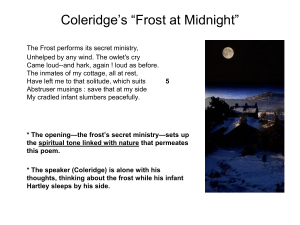
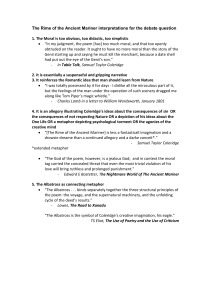
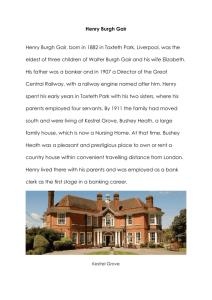
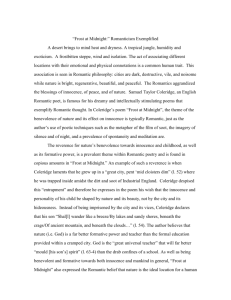
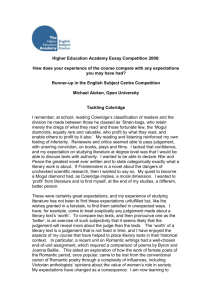
![Special Author: Coleridge [DOCX 17.00KB]](http://s3.studylib.net/store/data/006968656_1-dea8d59f2ad6dce7da91a635543a7277-300x300.png)
